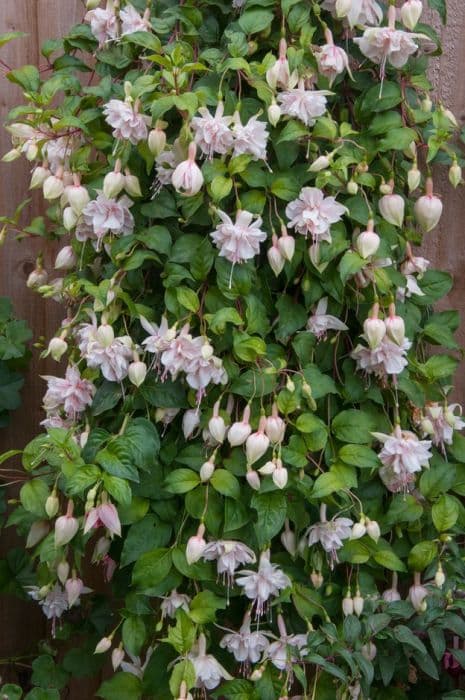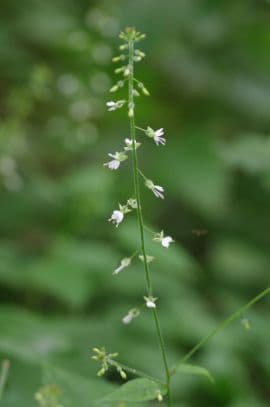Fuchsia Fuchsia 'Pink Marshmallow' (d)

ABOUT
The Fuchsia 'Pink Marshmallow' is a charming and decorative plant known for its unique and attractive flowers. This plant displays a proliferation of delightful blooms that hang gracefully from its branches. These flowers are distinctive in their form, featuring a layered appearance. The outer layer consists of four elongated, curved sepals that are typically a pale pink or blush color, tenderly cupping the inner petals. These sepals create an elegant backdrop for the voluptuous inner double petals, which emerge with a richer, deep pink to almost magenta hue. The petal arrangement gives off a fluffy, ruffled look, reminiscent of the softness of a marshmallow, which inspires the plant's name. The leaves of the Fuchsia 'Pink Marshmallow' form a lush backdrop for the extravagant blooms. They are usually dark green, with a slightly glossy surface and a delicate vein pattern that may be somewhat pronounced. The leaves can have a slight reddish tint near the edges, complementing the floral display. The overall foliage typically grows in a bushy habit, with the leaves distributed along the slender, arching branches, providing a full and verdant appearance even when the plant is not in flower. Additionally, the flowers of the Fuchsia 'Pink Marshmallow' attract hummingbirds and other pollinators with their vibrant coloration and rich nectar. This delightful characteristic, along with its ornate blooms and lush foliage, makes the Fuchsia 'Pink Marshmallow' a favored choice for gardeners looking to add a touch of whimsy and a splash of color to their outdoor spaces.
About this plant
 Names
NamesSynonyms
Pink Marshmallow Fuchsia, Lady's Eardrops
Common names
Fuchsia 'Pink Marshmallow'
 Toxicity
ToxicityTo humans
Fuchsia, including the 'Pink Marshmallow' variety, is generally considered non-toxic to humans. Most fuchsias, including their berries, are edible, and there are no common reports of poisoning from eating parts of these plants. However, as with any plant, some individuals may experience allergic reactions or gastrointestinal upset if they consume parts of the plant they are not accustomed to.
To pets
Fuchsia, including the 'Pink Marshmallow' cultivar, is not considered toxic to pets such as dogs and cats. While ingestion of the plant may cause mild gastrointestinal upset in some pets due to the novelty of the plant's taste and texture, it is not known to cause serious poisoning. As always, prevent your pets from eating large amounts of any non-food plants to avoid potential stomach distress.
 Characteristics
CharacteristicsLife cycle
Perennials
Foliage type
Deciduous
Color of leaves
Green
Flower color
Pink
Height
2feet 6inches (76 centimeters)
Spread
2feet 6inches (76 centimeters)
Plant type
Shrub
Hardiness zones
9
Native area
Central America
Benefits
 General Benefits
General Benefits- Attractive Blooms: Fuchsia 'Pink Marshmallow' is renowned for its striking and delicate hanging flowers, adding a touch of elegance to any garden.
- Pollinator Friendly: The flowers are known to attract hummingbirds and other pollinators, enhancing biodiversity and aiding in the pollination of nearby plants.
- Shade Tolerance: This plant is capable of thriving in partial shade, making it suitable for garden areas that may not receive full sunlight.
- Long Flowering Period: It has a lengthy blooming season that can extend from spring to fall, providing long-lasting visual interest.
- Versatility: Fuchsia 'Pink Marshmallow' can be grown in containers, hanging baskets or borders, offering flexibility in landscape design.
- Color Variety: The blooms present a vibrant pink and purple color combination that can complement a wide spectrum of other garden plants.
 Medical Properties
Medical PropertiesThis plant is not used for medical purposes.
 Air-purifying Qualities
Air-purifying QualitiesThis plant is not specifically known for air purifying qualities.
 Other Uses
Other Uses- Creating natural dyes: The flowers of the Fuchsia can be boiled to extract a purple-pink dye that can be used for coloring textiles, artwork, or even Easter eggs.
- Culinary decoration: The flowers of the Fuchsia, being edible, can be crystallized in sugar to make decorative cake toppings or salad garnishes.
- Edible flowers: The blossoms can be used fresh in salads, adding a touch of color and a slightly tangy flavor, or used in preserves and jellies for their unique taste.
- Photography subject: Fuchsia's vivid flowers make it a favorite among photographers looking to add a pop of color to their botanical portfolios.
- Fairy gardens: Fuchsias can be included in miniature fairy gardens due to their whimsical shape, adding to the enchantment of these tiny vistas.
- Art and craft inspiration: Artists can draw inspiration from the vibrant colors and unique shapes of Fuchsia flowers for their artwork or crafts.
- Potpourri ingredient: Dried Fuchsia flowers can be added to potpourri mixes for a subtle fragrance and beautiful color contrast.
- Teaching plant biology: Fuchsia is a good example to use in educational settings to teach about plant structure, pollination, and the co-evolution of flowers and their pollinators.
- Insect habitat: Planting Fuchsia can provide a habitat and nourishment for pollinators like hummingbirds and bees, thereby supporting local ecosystems.
- Wedding decor: Fuchsia flowers can be used in wedding bouquets or as table arrangements to add a splash of color and natural beauty to celebrations.
Interesting Facts
 Feng Shui
Feng ShuiThe Fuchsia is not used in Feng Shui practice.
 Zodiac Sign Compitability
Zodiac Sign CompitabilityThe Fuchsia is not used in astrology practice.
 Plant Symbolism
Plant Symbolism- Amiability and friendliness: The fuchsia plant is often associated with warmth and welcoming vibes, perhaps due to its inviting appearance and the soft, appealing shade typical of the 'Pink Marshmallow' variety.
- Confiding love: Fuchsia flowers, particularly in shades of pink, often symbolize a trusting and heartfelt love, suggesting a deep emotional connection without the intensity of red.
- Elegance and grace: The delicate petals and poised appearance of the Fuchsia 'Pink Marshmallow' convey a sense of refined beauty and sophistication.
- Good taste: The fuchsia plant can also be seen as a symbol of good taste and discernment, aligning well with the cultivated beauty of 'Pink Marshmallow' blooms.
- Vivacity and joy: With their playful form and vibrant colors, fuchsia blooms are frequently connected to positive, joyous emotions and an energetic spirit.
 Water
WaterFuchsias require consistent moisture, but it is crucial to avoid over-watering. The Fuchsia 'Pink Marshmallow' should be watered thoroughly when the top inch of soil feels dry to the touch, which typically means watering about once or twice a week. In hot or windy conditions, more frequent watering may be necessary. When watering, apply water directly to the soil at the base of the plant until the excess begins to drain from the bottom of the pot, usually using about half a gallon for a standard pot every week during the growing season.
 Light
LightFuchsia 'Pink Marshmallow', more commonly known just as fuchsia, thrives in bright, indirect light. It prefers a location that receives morning sunlight and afternoon shade, or dappled sunlight throughout the day. Full sun, especially during the hottest parts of the day, can scorch the leaves, while too much shade can inhibit blooming. Position the plant in a spot where the lighting conditions match these requirements for optimal growth.
 Temperature
TemperatureFuchsias flourish in a temperature range of 55 to 80 degrees Fahrenheit. To prevent damage, the Fuchsia 'Pink Marshmallow' should not be exposed to temperatures below 40 degrees Fahrenheit or above 85 degrees Fahrenheit. Ideal growth occurs between 60 to 70 degrees Fahrenheit, which often corresponds to spring and early summer weather in many climates.
 Pruning
PruningPruning fuchsias encourages a bushier growth habit and more flowers. The Fuchsia 'Pink Marshmallow' should be pruned in the spring, just before new growth begins. Cut back the tips of the branches by about a quarter to stimulate branching, and remove any dead or damaged wood. Pruning may be repeated lightly throughout the growing season to maintain shape and encourage continuous blooming.
 Cleaning
CleaningAs needed
 Soil
SoilThe Fuchsia, commonly known as 'Pink Marshmallow', thrives in a soil mix that is rich in organic matter, such as peat moss or a quality potting mix combined with perlite or vermiculite for improved drainage. The best pH for this soil mix is slightly acidic to neutral, ranging from 6.0 to 7.0.
 Repotting
RepottingFuchsias like 'Pink Marshmallow' should generally be repotted annually, especially when they are growing vigorously and start to become root-bound. Repotting is best done in late winter or early spring before new growth begins.
 Humidity & Misting
Humidity & MistingFuchsias such as 'Pink Marshmallow' flourish in moderate to high humidity levels, ideally between 60% to 70%. It's important to maintain consistent humidity for health and flower production.
 Suitable locations
Suitable locationsIndoor
Provide bright, indirect light and consistent moisture for indoor Pink Marshmallow.
Outdoor
Hang in partial shade; shelter from wind; keep moist; fertilize regularly.
Hardiness zone
9-11 USDA
 Life cycle
Life cycleThe life of Fuchsia 'Pink Marshmallow' begins with germination, which occurs when its seeds are sown in fertile, well-draining soil and provided with adequate moisture and warmth. Once the seedlings emerge, they enter the vegetative stage, developing a robust root system and foliage; this plant requires partial shade and protection from intense afternoon sun. As the plant matures, it enters the flowering stage, producing distinctive pink and purple hanging flowers that attract pollinators; this stage can be extended with proper care and deadheading of spent blooms. After pollination, the plant produces small fruits that contain seeds, marking the reproductive stage of its cycle. In colder climates, Fuchsia 'Pink Marshmallow' enters a period of dormancy during the winter, where it loses its leaves and requires less water. With the return of warmer temperatures and longer daylight hours, this herbaceous perennial awakens from dormancy, ready to begin a new cycle of growth and bloom.
 Propogation
PropogationPropogation time
Spring-Early Summer
The most common method of propagating Fuchsia 'Pink Marshmallow' is by softwood cuttings, preferably done in late spring to early summer when new growth is soft and flexible. To propagate, one would select a healthy, non-flowering shoot and cut a 3 to 4 inch (approximately 7.5 to 10 centimeters) piece just below a leaf node. The lower leaves should be removed, and the stem placed in a pot filled with a moist mixture of peat and perlite. Dipping the cut end in rooting hormone before planting can encourage root development. The cutting should be placed in a warm, well-lit area but out of direct sunlight and ideally covered with a plastic bag or placed in a propagator to maintain high humidity. Roots generally form within a few weeks, after which the new plant can be transferred to a larger pot with regular potting soil to continue growing.









![Fuchsia [Electric Lights]](/_next/image?url=https%3A%2F%2Fplants-admin.emdemapps.com%2Fimages%2Fplants%2F%2Fimages%2F604b5ba9b6455.png&w=640&q=75)